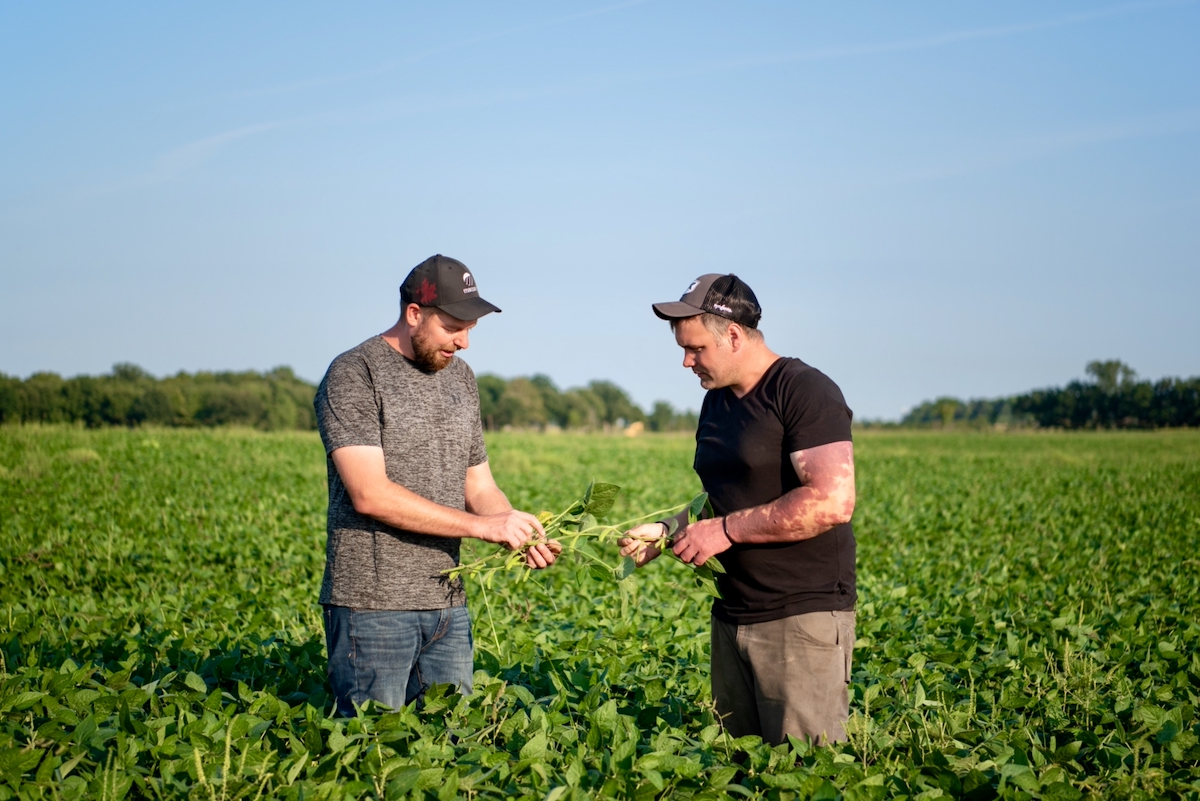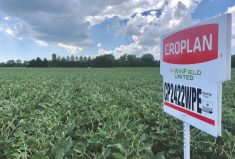The turn of the millennium was an amazing time to be involved in agriculture. Technologies like Roundup Ready, LibertyLink and Bt corn hybrids were in their infancy, with the promise of more to come from GMO labs. GPS yield monitors were new too, and the fledgling world of molecular “pharming” and “farmaceuticals” seemed to promise incredible new markets for products from insulin to edible vaccines, and even transplants for humans from other species.
Two decades later, there’s a danger that Canada is falling behind. Nor is our corps of Canadian researchers, engineers and farm entrepreneurs able to keep pace.
Read Also

Ontario farmers partner for success
Ontario business partners, Matt Bergman and DJ Wassenaar, have been farming together for 10 years. Their focus on integrating unconventional…
Are we dropping out of the technological elite?
A workshop organized last May by Ontario Agri-Food Technologies (OAFT) highlighted the crisis that has arisen in Canada and the need for Health Canada and the Canadian Food Inspection Agency (CFIA) to modernize the regulatory system. The urgency surrounding this move comes from two trends: the rejection of sound science principles by countries of the European Union (EU), and the advance of genome editing applications such as CRISPR.
Canada’s regulatory system is still focused on a plants with novel traits (PNT) approach and is unlikely to pick up where Europe is falling behind, much less be able to embrace new technologies.
That is of particular concern to a number of stakeholders, including Dr. Tyler Whale from OAFT, Ian Affleck from CropLife Canada and Dr. Stuart Smyth from the University of Saskatchewan. All were involved in the workshop and each spoke to the challenges associated with Canada’s regulatory system, what the country’s farmers stand to lose, and also what Canadian society and its economy may lose.
Country Guide spoke with them about this current predicament, what needs to change and what may happen if changes are not made.
Dr. Tyler Whale /
President of OAFT
Canada has taken a reactive approach instead of being proactive on research and development, Dr. Tyler Whale says. For instance, while other countries have ruled that innovations produced by CRISPR are not novel traits, which means they face a much lower regulatory hurdle, Canada is on the sidelines.
The European Union has taken a negative approach, rejecting sound scientific principles in favour of the politically expedient.
“But we’re laggards and that’s a signal to scientists and investors that Canada is not a leader, we’re not hungry for that opportunity to invest or innovate,” says Whale.
Canadian scientists are abandoning projects and they’re not making grant applications because of the uncertainty in the system. “We are at risk of being uninteresting to the innovation and investment ecosystem,” Whale says. “You’re not attracting them to your institutions to advance science using modern technology if you can’t be transparent and proactive about your regulatory position.”
Whale has been asked, “What does it matter if something is developed here in Canada?”
One answer is that if there’s a localized issue, it should have a local researcher or lab working on a solution. His example is work on cluster-tomato genetics at the Vineland Research and Innovation Centre near Hamilton. Historically, Ontario’s greenhouse sector has purchased its tomato genetics from the Netherlands. But summers there aren’t as hot and winters aren’t as cold, so growers can lose 15 per cent of their production when using Dutch genetics.
“Vineland developed tomato genetics that are good for the Ontario climate,” says Whale, adding that growers able to use the Vineland genetics in Canada could reap that 15 per cent as a yield increase. “Nobody else was willing to do that because we represent a fraction of one per cent of the total tomato genetics purchased in the world.”
Without a more proactive regulatory system, innovations that become relevant to international markets still have a greater chance of missing out on the opportunity of economic development. If Health Canada or the CFIA are only thinking of the tools but not creating the applications or the scale of the tool — the plants, the downstream manufacturing and the scale-up process — Canada still loses.
“I see this in the bio-economy where we have to come up with ways to harvest biomass,” says Whale. “But if we don’t harvest it and process it and make value-added products — and sell it all over the world and maybe include selling the suite of technologies that we’ve developed, what good is it? It really is a whole value-chain approach, not just enabling science. If I had to choose between science and commercializing science, I’d pick the latter for jobs, the economy and overall global competitiveness. However, Canada is very strong academically and we invent efficiently, so we need to commercialize better to capture the larger value.”
Another example that Whale cites as a reflection of Health Canada and the CFIA’s default to the PNT approach is work done at Metagenom Bio in Waterloo on a bacterium that naturally down-regulates the ethylene stress response in plants.
“It’s not transferring genetic material,” states Whale, adding that plants and humans interact with bacteria all the time. “This turning off of the ethylene stress response is essentially telling plants not to worry about salt or drought, and keep growing, but this company is hitting a regulatory wall in Canada and is therefore focusing commercial efforts, including capital investment, outside of this country. There are many examples just like this because Canada has a slow and arduous regulatory approach that’s overly concerned with efficacy that results in a competitive disadvantage, namely time and cost, compared to other more interesting markets like the U.S.”
Government agencies obeying the precautionary principle that Europe holds create another example of Canada playing the laggard, says Whale. In many cases with scientific research and development, it’s taking too long to make a decision.
“If there’s one thing worse than making the wrong decision, it’s making no decision at all,” says Whale. “You can evolve your regulatory and show you’re aligned with the general thinking of the U.S., Australia and Brazil on the importance of gene editing and technologies. But strategic companies will tailor their product or market it no matter the issue or regulatory regime.”
Ian Affleck /
Vice-president, plant biotech, CropLife Canada
According to Ian Affleck, Canada needs a regulatory system that is timely, predictable and transparent. The goal is to enable innovators both large and small to develop and launch products here.
“If we don’t act quickly to modernize the delivery of our system, the investments will go elsewhere, and we’ll lose our competitive edge with our international trade partners,” says Affleck. “There is an opportunity for Canada right now, when we see what’s happening in the European Union. The innovations are leaving Europe and can come here if we’re ready to receive it.”
The bones of the current system are good, but the delivery has not kept up with innovation and Canada needs to modernize that delivery so that innovators have a clear and predictable system under which to innovate.
“Right now, it’s quite vague and vagueness does not encourage investment,” says Affleck, noting losses can occur on two fronts. “We often focus on CRISPR and gene editing as the next wave, and if we miss out on that, we’ll really be held back. But the other element of plant breeding that suffers through vagueness is the general body of plant breeding. If our conventional breeding colleagues are struggling to figure out when they are and aren’t regulated, we’re missing opportunities there.”
Various researchers have revealed they’ve shelved at least one project because they couldn’t figure out the regulatory landscape. Instead, it needs to be open so breeders in Canada have the freedom to do what they’ve done for decades. But it also needs to seize the opportunity from what’s happening in other countries, including Europe’s rejection of science.
There is tremendous urgency in the situation, says Affleck: “Although we’re not to the point where business will default to research in the U.S., it could if we don’t get our system modernized to one that’s timely, predictable and transparent.
“We’re already seeing the impacts of our current system causing Canadian products to move elsewhere,” he adds. “So we are at a critical stage right now and we need to act in the immediate six to 12 months to get this fixed. The impacts of our system are already being felt, and we need to adjust quickly.”
The key elements he wants to see in a revised system are:
- Clear guidance to innovators on what triggers regulatory review.
- A tiered approach to data requirements to help plant breeders predict costs of regulations (if required).
- Removal of the spectre of regulation from conventional breeding activities.
- Alignment wherever possible with other science-based countries to have access to innovations when they come forward.
“If Canada can get our system perfected for the modern era of plant-breeding innovations, we can be an ambassador to the world about what the ideal scientific regulatory system can look like,” says Affleck. “As a trade-based nation and an agricultural exporter, we don’t just want good regulations at home, we want the best regulations and then we want to export those internationally to our trading partners.”
Dr. Stuart Smyth /
Associate professor, agricultural and resource economics, University of Saskatchewan
One of the common themes in this discussion is what’s happening in Europe and the flow of investment capital that’s leaving that region. It’s an opportunity lost if Canada can’t modernize its regulatory system and acknowledge that many of the scientific precepts entrenched in our regulations no longer apply with the same rigidity. Dr. Stuart Smyth points to herbicide-tolerant canola in Western Canada, a staple product for the past 25 years.
“The last year that there was a non-herbicide-tolerant canola variety in field trials was 2012,” Smyth notes. Since varieties typically last for three to four years, he estimates that Canada hasn’t produced any non-herbicide-tolerant canola for the last four or five years. “If we say that 98 or 99 per cent of what we’re producing in Canada is herbicide-tolerant — whether it’s genetically modified or mutagenesic — why would we still be treating this as novel? At some point, there needs to be some clarification put into our regulatory framework that novelty no longer applies.”
The concern on that front is that Smyth has heard some companies stating that with the application of genome- editing technologies, they are going to focus on the American market. This is in light of the USDA announcement that simple gene deletion will not be regulated.
“Certainly, there’s a significant potential for the United States to pull ahead of Canada in terms of being viewed as an attractive space for agricultural investments,” says Smyth. “Fundamentally, Canada is going to have to decide how to keep pace with American regulations.”
In terms of significant differences between Canada’s reputation for excellence 20 years ago versus today’s lapses in progress facing innovators, researchers and breeders, Smyth points to the sheer volume of information. Company dossier packages submitted for regulatory approval 20 years ago were 50 to 100 pages; today they’re 1,000 to 1,200.
“We’re able to test and quantitatively know — in parts per billion and even getting into parts per trillion,” says Smyth. “That ability has driven an increase in the testing side of things. But there’s no ability to come back and say Canadians are safer because we’re able to test it at increasingly refined levels.”
The other major difference in the past 20 years from Smyth’s perspective is increased costs of regulations, particularly as commodity groups have developed protocols around international market acceptance for GM varieties. That has pushed Canada’s public sector away from using the technology, simply because it was impossible to get research funding for that increased regulatory cost.
“Some estimates are saying that to get global regulatory acceptance for a new GM variety is north of $130 million,” explains Smyth. “There’s no research grant in Canada that would give a university or a federal ag research lab the funding necessary to get a variety approval. We’ve seen the public institutions use these technologies internally for proof of concept yet they go back and they’re using mutagenesis, a technology that’s been around for 80 years, to get close to what they would be able to do with more precise and newer breeding technologies.”
It’s in genome editing that Canada has to secure its opportunity for investment and development. Discovery using CRISPR could incentivize more regionalization in response to climate change. Parts of the Prairies would benefit from more drought-tolerant canola varieties while other parts could deal with salinity or excess moisture.
“Canada needs to provide some clarity to the PNT process,” says Smyth. “Most of our commodity-producing competitors — the U.S., Argentina, Brazil, Australia — have said if you’re simply knocking out genes, that will not require any comparison to a GMO. It’s imperative for Canada to keep pace, and some clarity like that would definitely improve things.”
This article was originally published in the October 2019 issue of the Soybean Guide.
















